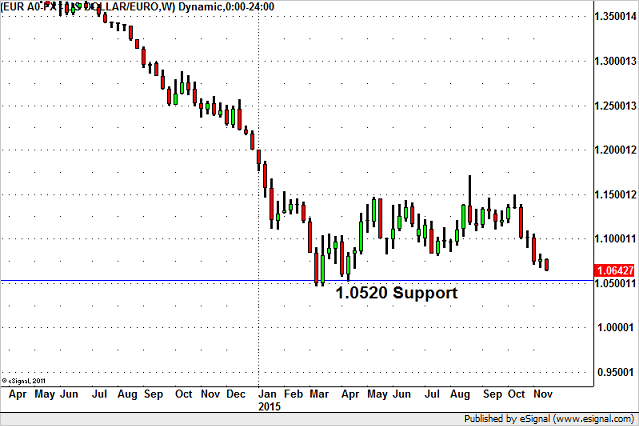By Kathy Lien, Managing Director of FX Strategy for BK Asset Management.
The biggest story in Tuesday's forex market was the decline in EUR/USD. The currency pair dropped to its weakest level in 7 months on growing expectations of ECB easing. Confidence in the Eurozone economy has been shaken by the Paris attacks and investors are expressing concern about the region’s economy through its currency. In the past month EUR/USD has lost more than 7% of its value and, after the attacks in Paris, it could be vulnerable to another 5% decline. Tuesday’s move took EUR/USD beyond its previous multi-month low 1.0674 and as indicated in the chart below, there is no support for the pair until 1.0520 -- the April low. We know that there will be significant support at 1.05 and 1.0460, the 12-year low but beyond that, there is no major support until parity. The forces driving the EUR/USD lower are fundamentally significant and unless these drivers change, the path of least resistance for the pair will be lower. This requires the ECB to move forward with easing monetary policy next month and the Fed to raise interest rates. At this stage, ECB easing is almost certain but we still do not know if the Fed will proceed with a rate hike. France is the second-largest economy in the Eurozone and the attacks will have a significant impact on economic confidence, trade and tourism activity. In recent months, France’s economy returned to growth as Germany was slowing but now with the two regional powerhouses both experiencing troubles, the ECB will have no choice but to act.
In contrast, the dollar’s broad-based gains and the relatively benign move in Treasuries on Tuesday suggest that investors haven’t given up on the Fed. Even after the disappointing industrial production and NAHB housing-market reports, the market believes that the Fed could still raise interest rates. Inflation is a big part of the argument. According to Tuesday morning’s consumer-price report, inflation is on the rise. Between that and the recovery in labor data, the U.S. central bank could still move forward with policy normalization. We don’t expect Wednesday’s FOMC minutes to pose much threat to the greenback. In fact it should help more than hurt the U.S. dollar because when it last met, the Fed sounded eager to tighten despite weaker data. Yet with ISIS’ threats, it is still an evolving situation. If there is another attack and capital markets freeze up, then a hike is off the table. The most important thing to do right now is to listen to Fed speak. Many policymakers are scheduled to speak this week and the uncertainty about Fed policy makes it extremely important to watch for any change in views.
Sterling has been surprisingly resilient in the face of U.S. dollar strength, which can be attributed to EUR/GBP selling. The exodus out of euros has not only benefitted the greenback but also the British pound because the Federal Reserve and the Bank of England are the only 2 central banks thinking about raising interest rates. However the BoE is much further away from acting than the Fed. Its Quarterly Inflation Report was extremely dovish even as U.K. data continues to improve. On Tuesday morning we learned that consumer prices rose 0.1% in October. Of course that increase is nominal and year-over-year, CPI is still in negative territory. The latest sell-off in EUR/GBP will only make the central bank even less eager to raise interest rates. So while GBP/USD is holding steady for now, it's rolling over and vulnerable to renewed losses.
The New Zealand dollar dropped to a 1-month low Tuesday versus the U.S. dollar. Dairy prices declined for the third time in a row by the largest amount since July 2015. The Reserve Bank of New Zealand is not going to be happy with this latest news and expectations for another rate cut should grow. When it last met, the RBNZ expressed reservations about the recovery in dairy prices and its caution is now justified. Typically, a drop in dairy prices tends to have continuation and as such we have strong reason to believe that the New Zealand dollar will continue to fall.
The Australian dollar was Tuesday's best-performing currency after the U.S. dollar. What is surprising about the move is that it comes after slightly dovish RBA minutes. According to the Reserve Bank, China, wages and the mining sector remain its primary concerns and low inflation affords scope for further easing. It pointed to stronger employment and consumption -- but that comment notwithstanding, the minutes were hardly hawkish. Nonetheless the market no longer expects the RBA to ease and the lack of surprises in Monday night’s statement helped to lift the Australian dollar.
USD/CAD traded slightly lower Tuesday despite the decline in oil prices. While the currency pair is in striking distance of its September high, we do not expect that level to be broken. There is a significant amount of technical support at $40 a barrel and we believe that support will hold -- and if we're right, it should help to halt the USD/CAD rally.

